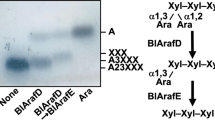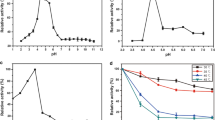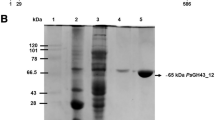Abstract
Xylooligosaccharides (XOSs) and arabinoxylooligosaccharides (AXOSs) are major oligosaccharides derived from arabinoxylan. In our previous report, Corynebacterium glutamicum was engineered to utilize XOSs by introducing Corynebacterium alkanolyticum xyloside transporter and β-xylosidase. However, this strain was unable to consume AXOSs due to the absence of α-l-arabinofuranosidase activity. In this study, to confer AXOS utilization ability on C. glutamicum, two putative arabinofuranosidase genes (abf51A and abf51B) were isolated from C. alkanolyticum by the combination of degenerate PCR and genome walking methods. Recombinant Abf51A and Abf51B heterologously expressed in Escherichia coli showed arabinofuranosidase activities toward 4-nitrophenyl-α-l-arabinofuranoside with k cat values of 150 and 63, respectively, with optimum at pH 6.0 to 6.5. However, Abf51A showed only a slight activity toward AXOSs and was more susceptible to product inhibition by arabinose and xylose than Abf51B. Introduction of abf51B gene into the C. glutamicum XOS-utilizing strain enabled it to utilize AXOSs as well as XOSs. The xylI gene encoding a putative xylanase was found upstream of the C. alkanolyticum xyloside transporter genes. A signal peptide was predicted at the N-terminus of the xylI-encoding polypeptide, which indicated XylI was a secreted protein. Recombinant mature XylI protein heterologously expressed in E. coli showed a xylanase activity toward xylans from various plant sources with optimum at pH 6.5, and C. glutamicum recombinant strain expressing native XylI released xylose, xylobiose, xylotriose, and arabino-xylobiose from arabinoxylan. Finally, introduction of the xylI gene into the C. glutamicum AXOS-utilizing strain enabled it to directly utilize arabinoxylan.






Similar content being viewed by others
References
Ali MK, Hayashi H, Karita S, Goto M, Kimura T, Sakka K, Ohmiya K (2001) Importance of the carbohydrate-binding module of Clostridium stercorarium Xyn10B to xylan hydrolysis. Biosci Biotechnol Biochem 65:41–47
Bailey MJ, Biely P, Poutanen K (1992) Interlaboratory testing of methods for assay of xylanase activity. J Biotechnol 23:257–270
Beg Q, Kapoor M, Mahajan L, Hoondal G (2001) Microbial xylanases and their industrial applications: a review. Appl Microbiol Biotechnol 56:326–338. doi:10.1007/s002530100704
Bengtsson S, Åman P, Andersson RE (1992) Structural studies on water-soluble arabinoxylans in rye grain using enzymatic hydrolysis. Carbohydr Polym 17:277–284
Bolam DN, Ciruela A, McQueen-Mason S, Simpson P, Williamson MP, Rixon JE, Boraston A, Hazlewood GP, Gilbert HJ (1998) Pseudomonas cellulose-binding domains mediate their effects by increasing enzyme substrate proximity. Biochem J 331:775–781. doi:10.1042/bj3310775
Boraston AB, Creagh AL, Alam MM, Kormos JM, Tomme P, Haynes CA, Warren RAJ, Kilburn DG (2001) Binding specificity and thermodynamics of a family 9 carbohydrate-binding module from Thermotoga maritima xylanase 10A. Biochemistry 40:6240–6247
Boraston AB, Kwan E, Chiu P, Warren RAJ, Kilburn DG (2003) Recognition and hydrolysis of noncrystalline cellulose. J Biol Chem 278:6120–6127. doi:10.1074/jbc.M209554200
Danchin A (2009) Cells need safety valves. BioEssays 31:769–773
Ebringerová A, Heinze T (2000) Xylan and xylan derivatives—biopolymers with valuable properties, 1. Naturally occurring xylans structures, isolation procedures and properties. Macromol Rapid Commun 21:542–556
Gilbert HJ (2010) The biochemistry and structural biology of plant cell wall deconstruction. Plant Physiol 153:444–455. doi:10.1104/pp.110.156646
Gruppen H, Kormelink FJM, Voragen AGJ (1993) Water-unextractable cell wall material from wheat flour. 3. A structural model for arabinoxylans. J Cereal Sci 18:111–128
Hasegawa S, Uematsu K, Natsuma Y, Suda M, Hiraga K, Jojima T, Inui M, Yukawa H (2012) Improvement of the redox balance increases l-valine production by Corynebacterium glutamicum under oxygen deprivation conditions. Appl Environ Microbiol 78:865–875. doi:10.1128/aem.07056-11
Hervé C, Rogowski A, Blake AW, Marcus SE, Gilbert HJ, Knox JP (2010) Carbohydrate-binding modules promote the enzymatic deconstruction of intact plant cell walls by targeting and proximity effects. Proc Natl Acad Sci U S A 107:15293–15298. doi:10.1073/pnas.1005732107
Inui M, Kawaguchi H, Murakami S, Vertès AA, Yukawa H (2004) Metabolic engineering of Corynebacterium glutamicum for fuel ethanol production under oxygen-deprivation conditions. J Mol Microbiol Biotechnol 8:243–254
Kim Y, Ximenes E, Mosier NS, Ladisch MR (2011) Soluble inhibitors/deactivators of cellulase enzymes from lignocellulosic biomass. Enzym Microb Technol 48:408–415
Kim SJ, Hyeon JE, Jeon SD, G-w C, Han SO (2014) Bi-functional cellulases complexes displayed on the cell surface of Corynebacterium glutamicum increase hydrolysis of lignocelluloses at elevated temperature. Enzym Microb Technol 66:67–73
Koita K, Rao CV (2012) Identification and analysis of the putative pentose sugar efflux transporters in Escherichia coli. PLoS One 7:e43700
Kondo A, Shigechi H, Abe M, Uyama K, Matsumoto T, Takahashi S, Ueda M, Tanaka A, Kishimoto M, Fukuda H (2002) High-level ethanol production from starch by a flocculent Saccharomyces cerevisiae strain displaying cell-surface glucoamylase. Appl Microbiol Biotechnol 58:291–296. doi:10.1007/s00253-001-0900-9
Lagaert S, Pollet A, Delcour JA, Lavigne R, Courtin CM, Volckaert G (2010) Substrate specificity of three recombinant α-l-arabinofuranosidases from Bifidobacterium adolescentis and their divergent action on arabinoxylan and arabinoxylan oligosaccharides. Biochem Biophys Res Commun 402:644–650
Lagaert S, Pollet A, Courtin CM, Volckaert G (2014) β-Xylosidases and α-l-arabinofuranosidases: accessory enzymes for arabinoxylan degradation. Biotechnol Adv 32:316–332
Lee SH, Lee YE (2014) Cloning and characterization of a multidomain GH10 xylanase from Paenibacillus sp. DG-22. J Microbiol Biotechnol 24:1525–1535
Lesnik EA, Sampath R, Levene HB, Henderson TJ, McNeil JA, Ecker DJ (2001) Prediction of rho-independent transcriptional terminators in Escherichia coli. Nucleic Acids Res 29:3583–3594
Liab K, Azadi P, Collins R, Tolan J, Kim JS, Eriksson K-EL (2000) Relationships between activities of xylanases and xylan structures. Enzym Microb Technol 27:89–94
Liu Z, Inokuma K, Ho S-H, Rd H, Hasunuma T, van Zyl WH, Kondo A (2015) Combined cell-surface display- and secretion-based strategies for production of cellulosic ethanol with Saccharomyces cerevisiae. Biotechnol Biofuels 8:1–12. doi:10.1186/s13068-015-0344-6
Lombard V, Golaconda Ramulu H, Drula E, Coutinho PM, Henrissat B (2014) The carbohydrate-active enzymes database (CAZy) in 2013. Nucleic Acids Res. doi:10.1093/nar/gkt1178
MacLeod AM, Lindhorst T, Withers SG, Warren RAJ (1994) The acid/base catalyst in the exoglucanase/xylanase from Cellulomonas fimi is glutamic acid 127: evidence from detailed kinetic sstudies of mutants. Biochemistry 33:6371–6376
Margolles A, de los Reyes-Gavilán CG (2003) Purification and aunctional characterization of a novel α-l-arabinofuranosidase from Bifidobacterium longum B667. Appl Environ Microbiol 69:5096–5103. doi:10.1128/aem.69.9.5096-5103.2003
Notenboom V, Boraston AB, Kilburn DG, Rose DR (2001) Crystal structures of the family 9 carbohydrate-binding module from Thermotoga maritima xylanase 10A in native and ligand-bound forms. Biochemistry 40:6248–6256
Okibe N, Suzuki N, Inui M, Yukawa H (2010) Antisense-RNA-mediated plasmid copy number control in pCG1-family plasmids, pCGR2 and pCG1, in Corynebacterium glutamicum. Microbiology 156:3609–3623. doi:10.1099/mic.0.043745-0
Paës G, Berrin J-G, Beaugrand J (2012) GH11 xylanases: structure/function/properties relationships and applications. Biotechnol Adv 30:564–592
Pollet A, Delcour JA, Courtin CM (2010) Structural determinants of the substrate specificities of xylanases from different glycoside hydrolase families. Crit Rev Biotechnol 30:176–191
Rhee MS, Wei L, Sawhney N, Kim YS, Rice JD, Preston JF (2016) Metabolic potential of Bacillus subtilis 168 for the direct conversion of xylans to fermentation products. Appl Microbiol Biotechnol 100:1501–1510. doi:10.1007/s00253-015-7124-x
Riley J, Butler R, Ogilvie D, Finniear R, Jenner D, Powell S, Anand R, Smith JC, Markham AF (1990) A novel, rapid method for the isolation of terminal sequences from yeast artificial chromosome (YAC) clones. Nucleic Acids Res 18:2887–2890. doi:10.1093/nar/18.10.2887
Sakai S, Tsuchida Y, Okino S, Ichihashi O, Kawaguchi H, Watanabe T, Inui M, Yukawa H (2007) Effect of lignocellulose-derived inhibitors on growth of and ethanol production by growth-arrested Corynebacterium glutamicum R. Appl Environ Microbiol 73:2349–2353. doi:10.1128/aem.02880-06
Sambrook J, Russell D (2001) Molecular cloning: a laboratory manual. Cold Spring Harbor Laboratory Press, Cold Spring Harbor
Sanda T, Hasunuma T, Matsuda F, Kondo A (2011) Repeated-batch fermentation of lignocellulosic hydrolysate to ethanol using a hybrid Saccharomyces cerevisiae strain metabolically engineered for tolerance to acetic and formic acids. Bioresour Technol 102:7917
Sasaki M, Jojima T, Inui M, Yukawa H (2008) Simultaneous utilization of D-cellobiose, D-glucose, and D-xylose by recombinant Corynebacterium glutamicum under oxygen-deprived conditions. Appl Microbiol Biotechnol 81:691–699. doi:10.1007/s00253-008-1703-z
Sasaki M, Jojima T, Kawaguchi H, Inui M, Yukawa H (2009) Engineering of pentose transport in Corynebacterium glutamicum to improve simultaneous utilization of mixed sugars. Appl Microbiol Biotechnol 85:105–115. doi:10.1007/s00253-009-2065-x
Shallom D, Belakhov V, Solomon D, Gilead-Gropper S, Baasov T, Shoham G, Shoham Y (2002a) The identification of the acid–base catalyst of α-arabinofuranosidase from Geobacillus stearothermophilus T-6, a family 51 glycoside hydrolase. FEBS Lett 514:163–167
Shallom D, Belakhov V, Solomon D, Shoham G, Baasov T, Shoham Y (2002b) Detailed kinetic analysis and identification of the nucleophile in α-L-arabinofuranosidase from Geobacillus stearothermophilus T-6, a family 51 glycoside hydrolase. J Biol Chem 277:43667–43673. doi:10.1074/jbc.M208285200
Shi P, Li N, Yang P, Wang Y, Luo H, Bai Y, Yao B (2010) Gene cloning, expression, and characterization of a family 51 α-l-arabinofuranosidase from Streptomyces sp. S9. Appl Biochem Biotechnol 162:707–718. doi:10.1007/s12010-009-8816-4
Shin H-D, McClendon S, Vo T, Chen RR (2010) Escherichia coli binary culture engineered for direct fermentation of hemicellulose to a biofuel. Appl Environ Microbiol 76:8150–8159. doi:10.1128/aem.00908-10
Sun J, Wen F, Si T, Xu J-H, Zhao H (2012) Direct conversion of xylan to ethanol by recombinant Saccharomyces cerevisiae strains displaying an engineered minihemicellulosome. Appl Environ Microbiol 78:3837–3845. doi:10.1128/aem.07679-11
Tsuge Y, Hori Y, Kudou M, Ishii J, Hasunuma T, Kondo A (2014) Detoxification of furfural in Corynebacterium glutamicum under aerobic and anaerobic conditions. Appl Microbiol Biotechnol 98:8675–8683. doi:10.1007/s00253-014-5924-z
Van Dyk JS, Pletschke BI (2012) A review of lignocellulose bioconversion using enzymatic hydrolysis and synergistic cooperation between enzymes—factors affecting enzymes, conversion and synergy. Biotechnol Adv 30:1458–1480
Van Laere KM, Beldman G, Voragen AG (1997) A new arabinofuranohydrolase from Bifidobacterium adolescentis able to remove arabinosyl residues from double-substituted xylose units in arabinoxylan. Appl Microbiol Biotechnol 47:231–235
Van Laere JKM, Voragen LCH, Kroef T, Van den Broek MLA, Beldman G, Voragen JAG (1999) Purification and mode of action of two different arabinoxylan arabinofuranohydrolases from Bifidobacterium adolescentis DSM 20083. Appl Microbiol Biotechnol 51:606–613. doi:10.1007/s002530051439
Vertès AA, Inui M, Kobayashi M, Kurusu Y, Yukawa H (1993) Presence of mrr- and mcr-like restriction systems in coryneform bacteria. Res Microbiol 144:181–185
Watanabe A, Hiraga K, Suda M, Yukawa H, Inui M (2015) Functional characterization of Corynebacterium alkanolyticum β-xylosidase and xyloside ABC transporter in Corynebacterium glutamicum. Appl Environ Microbiol 81:4173–4183. doi:10.1128/aem.00792-15
Ximenes E, Kim Y, Mosier N, Dien B, Ladisch M (2011) Deactivation of cellulases by phenols. Enzym Microb Technol 48:54–60
Yang Y, Zhang L, Guo M, Sun J, Matsukawa S, Xie J, Wei D (2015) Novel α-l-arabinofuranosidase from Cellulomonas fimi ATCC 484 and its substrate-specificity analysis with the aid of computer. J Agric Food Chem 63:3725–3733
Yim SS, Choi JW, Lee SH, Jeong KJ (2016) Modular optimization of a hemicellulose-utilizing pathway in Corynebacterium glutamicum for consolidated bioprocessing of hemicellulosic biomass. ACS Synth Biol 5:334–343
Yukawa H, Omumasaba CA, Nonaka H, Kós P, Okai N, Suzuki N, Suda M, Tsuge Y, Watanabe J, Ikeda Y, Vertès AA, Inui M (2007) Comparative analysis of the Corynebacterium glutamicum group and complete genome sequence of strain R. Microbiology 153:1042–1058. doi:10.1099/mic.0.2006/003657-0
Author information
Authors and Affiliations
Corresponding author
Ethics declarations
Conflict of interest
The authors declare that they have no conflict of interest.
Ethical approval
This article does not contain any studies with human participants or animals by any of the authors.
Electronic supplementary material
ESM 1
(PDF 44 kb)
Rights and permissions
About this article
Cite this article
Kuge, T., Watanabe, A., Hasegawa, S. et al. Functional analysis of arabinofuranosidases and a xylanase of Corynebacterium alkanolyticum for arabinoxylan utilization in Corynebacterium glutamicum . Appl Microbiol Biotechnol 101, 5019–5032 (2017). https://doi.org/10.1007/s00253-017-8280-y
Received:
Revised:
Accepted:
Published:
Issue Date:
DOI: https://doi.org/10.1007/s00253-017-8280-y




